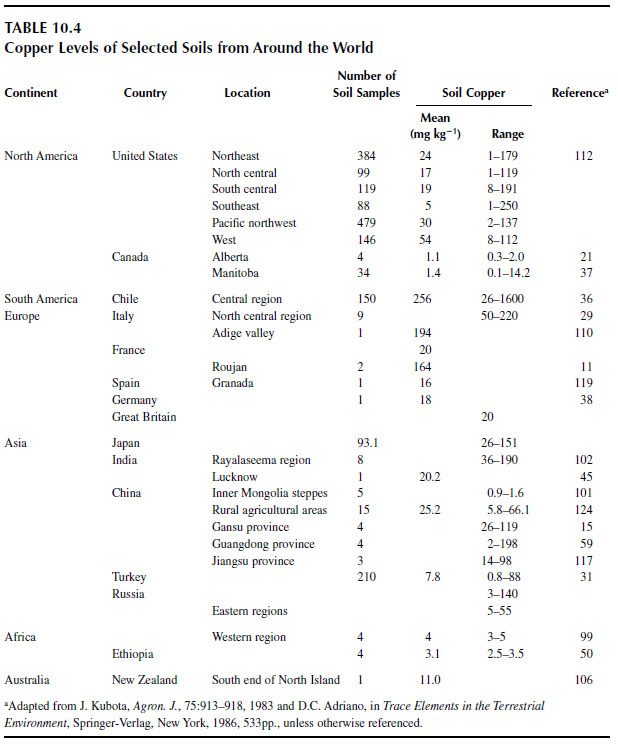Geological Distribution of Copper in Soils
Copper exists mainly as Cu (I) and Cu (II), but can occur in metallic form (Cuo) in some ores (40). Copper occurs in soils as sulfide minerals and less stable oxides, silicates, sulfates and carbonates (40). The most abundant copper-containing mineral is chalcopyrite (CuFeS2) (3). Copper can also be substituted isomorphously for Mn, Fe, and Mg in various minerals (97).Copper is most abundant in mafic (rich in Mg, Ca, Na, and Fe, commonly basalt and gabbro) rocks, with minimal concentration in carbonate rocks. Mafic rocks contain 60 to 120 mg Cu kg-1; ultramafic rocks (deeper in the crust than mafic rocks) contain 10 to 40 mg kg-1, and acid rocks (granites, gneisses, rhyolites, trachytes, and dacites) contain 2 to 30 mg kg-1. Limestones and dolomites contain 2 to10 mg Cu kg-1; sandstones contain 5 to 30 mg kg-1; shales contain about 40mg kg-1, and argillaceous sediments have about 40 to 60 mg kg-1 (9). Examples of copper-containing minerals include malachite (Cu2(OH)2CO3), azurite (Cu3(OH)2(CO3)2), cuprite (Cu2O), tenorite (CuO), chalcocite (Cu2S), covellite (CuS), chalcopyrite (CuFeS2), bornite (Cu5FeS4), and silicate chrysocolla (CuSiO3 2H2O) (40). Chalcopyrite (CuFeS2) is a brass-yellow ore that accounts for approximately 50% of the world copper deposits. These minerals easily release copper ions during weathering and under acidic conditions (9). The weathering of copper deposits produces blue and green minerals often sought by prospectors (3).
Because copper ions readily precipitate with sulfide, carbonate, and hydroxide ions, it is rather immobile in soils, showing little variation in soil profiles (9). Copper in soil is held strongly to organic matter, and it is common to find more copper in the topsoil horizons than in deeper zones. Four tropical agricultural soils (Bougouni, Kangaba, Baguin�da, and Gao) in Africa contained 3 to 5 mg Cu kg-1 despite differences in climatic zone and texture (99). Copper in these soils was associated mostly with the organic soil fraction. The minerals governing the solubility of Cu2+ in soils are not known (100).
The global concentration of total copper in soils ranges from 2 to 200 mg kg-1, with a mean concentration of 30 mg kg-1 (40) (Table 10.4). Kabata-Pendias and Pendias (9) reported that worldwide copper concentrations in soils commonly range between 13 and 24 mg kg-1. Reviews by Kubota (30), Adriano (4), and Kabata-Pendias and Pendias (9) present detailed descriptions of global copper distribution. The concentration of copper in soils of the United States ranges from 1 to 40 mg Cu kg-1, with an average content of 9 mg kg-1 (30). Agricultural soils in central Italy ranged from 50 to 220 mg Cu kg-1 (29). Agricultural soils in central Chile were grouped into two categories: one cluster containing 162 mg Cu kg-1 and another cluster containing 751 mg kg-1 (36). However, much of this copper was associated with very sparingly soluble forms and was of low bioavailability to crop plants. Fifteen agricultural soils in China ranged from 5.8 to 66.1 mg Cu kg-1 (101). Eight soils classified as Alfisols, Inceptisols, or Vertisols in India ranged from 1.12 to 5.67mg Cu kg-1 (102). On the other hand, alum shale and moraine soils from alum shale parent material in India contained 65 and 112 mg Cu kg-1, respectively (103). Five grassland soils in the Xilin river watershed of Inner Mongolia ranged from 0.89 to 1.62 mg Cu kg-1 (101). Four calcareous soils from the Baiyin region, Gansu providence, China, ranged from 26to 199 mg Cu kg-1, the higher levels resulting from irrigation with wastewater from nonferrous metal mining and smelting operations in the 1950s (15). Similar copper soil concentrations were found in mine tailings (Pb-Zn) in Guangdong providence, China (59). The mean copper content of a Canadian soil at 3 to 6.3 km from a metal-processing smelter was 1400 to 3700 mg kg-1 (104).
 |




